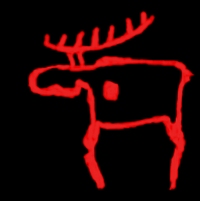Related Research Articles
Animism is the belief that objects, places, and creatures all possess a distinct spiritual essence. Animism perceives all things—animals, plants, rocks, rivers, weather systems, human handiwork, and in some cases words—as animated and alive. Animism is used in anthropology of religion as a term for the belief system of many Indigenous peoples, in contrast to the relatively more recent development of organized religions. Animism focuses on the metaphysical universe, with a specific focus on the concept of the immaterial soul.

A ghost is the soul or spirit of a dead person or non-human animal that is believed to be able to appear to the living. In ghostlore, descriptions of ghosts vary widely, from an invisible presence to translucent or barely visible wispy shapes to realistic, lifelike forms. The deliberate attempt to contact the spirit of a deceased person is known as necromancy, or in spiritism as a séance. Other terms associated with it are apparition, haunt, phantom, poltergeist, shade, specter, spirit, spook, wraith, demon, and ghoul.
Atua are the gods and spirits of the Polynesian peoples such as the Māori or the Hawaiians ; the Polynesian word literally means "power" or "strength" and so the concept is similar to that of mana. Today, it is also used for the monotheistic conception of God. Especially powerful atua included:
In Polynesian languages the word aitu refers to ghosts or spirits, often malevolent. The word is common to many languages of Western and Eastern Polynesia. In the mythology of Tonga, for example, ʻaitu or ʻeitu are lesser gods, many being patrons of specific villages and families. They often take the form of plants or animals, and are often more cruel than other gods. These trouble-making gods are regarded as having come from Samoa. The Tongan word tangi lauʻaitu means to cry from grief, to lament.

Finnish paganism is the indigenous pagan religion in Finland and Karelia prior to Christianisation. It was a polytheistic religion, worshipping a number of different deities. The principal god was the god of thunder and the sky, Ukko; other important gods included Jumo (Jumala), Ahti, and Tapio. Jumala was a sky god; today, the word "Jumala" refers to all gods in general. Ahti was a god of the sea, waters and fish. Tapio was the god of forests and hunting.

Philippine mythology is the body of stories and epics originating from, and part of, the indigenous Philippine folk religions, which include various ethnic faiths distinct from one another. Philippine mythology is incorporated from various sources, having similarities with Indonesian and Malay myths, as well as Hindu, Muslim, Shinto, Buddhist, and Christian traditions, such as the notion of heaven, hell, and the human soul. Philippine mythology attempts to explain the nature of the world through the lives and actions of heroes, deities, and mythological creatures. The majority of these myths were passed on through oral tradition, and preserved through the aid of community spiritual leaders or shamans and community elders.

The Tao people are an Austronesian ethnic group native to the tiny outlying Orchid Island of Taiwan. They have a maritime culture, with great ritual and spiritual significance placed on boat-building and fishing. Their ways of life have been threatened by the continued emigration to the mainland of Taiwan in search of jobs and education. As a result, the continuation of past traditions has been hindered. Despite being linked to both other Taiwanese indigenous peoples and Filipino populations, the Tao people remain unique in their customs and cultural practices.

Filipino shamans, commonly known as Babaylan, were shamans of the various ethnic groups of the pre-colonial Philippine islands. These shamans specialized in communicating, appeasing, or harnessing the spirits of the dead and the spirits of nature. They were almost always women or feminized men. They were believed to have spirit guides, by which they could contact and interact with the spirits and deities and the spirit world. Their primary role were as mediums during pag-anito séance rituals. There were also various subtypes of babaylan specializing in the arts of healing and herbalism, divination, and sorcery.

Indigenous Philippine folk religions are the distinct native religions of various ethnic groups in the Philippines, where most follow belief systems in line with animism. Generally, these indigenous folk religions are referred to as Anito or Anitism or the more modern and less ethnocentric Dayawism. 0.23% of the population of the Philippines are affiliated with the indigenous Philippine folk religions according to the 2020 national census, an increase from the previous 0.19% from the 2010 census.

Hantu is the Malay and Indonesian word for spirit or ghost, sometimes it is also the Tagalog word for ghost. In modern usage it generally means spirits of the dead but has also come to refer to any legendary invisible being, such as demons. In its traditional context the term also referred to animistic nature spirits or ancestral souls. The word is derived from Proto-Malayo-Polynesian *qanitu and Proto-Austronesian *qaNiCu. Cognates in other Austronesian languages include the Micronesian aniti, Lio language nitu, Yami anito, Taivoan alid, Seediq and Atayal utux, Bunun hanitu or hanidu, Polynesian aitu or atua, and Tsou hicu among the Formosan languages. In terms of concept and place in traditional folklore, it is most similar to the Filipino anito.

There are many Malay ghost myths, remnants of old animist beliefs that have been shaped by Hindu-Buddhist cosmology and later Muslim influences, in the modern states of Brunei, Indonesia, Malaysia, Singapore and among the Malay diaspora in neighbouring Southeast Asian countries. The general word for ghost is hantu, of which there exist a wide variety. Some ghost concepts such as the female vampires pontianak and penanggal are shared throughout the region. While traditional belief does not consider all ghosts as necessarily evil, Malaysian popular culture tends to categorise them all as types of evil djinn.
Hantu Air, Puaka Air or Mambang Air is the Malay translation for Spirit of the Water or Water Ghost, which according to animist traditions in Maritime Southeast Asia, is the unseen inhabitant of watery places such as rivers, lakes, seas, swamps and even ditches. Communication between humans and Hantu Air occur in situations based on the well-being of an environment and can be positive or negative. Water spirits are called on and communicated with through ceremonies, rituals, incantations, and in extreme cases exorcisms. Hantu Air is associated with bad things happening to people including missing persons, drowning, flooding and many other incidents.

The Sakizaya are Taiwanese indigenous peoples with a population of approximately 1,000. They primarily live in Hualien, where their culture is centered.

The Ivatan people are an Austronesian ethnolinguistic group native to the Batanes and Babuyan Islands of the northernmost Philippines. They are genetically closely-related to other ethnic groups in Northern Luzon, but also share close linguistic and cultural affinities to the Tao people of Orchid Island in Taiwan.
Soul dualism, also called dualistic pluralism or multiple souls, is a range of beliefs that a person has two or more kinds of souls. In many cases, one of the souls is associated with body functions and the other one can leave the body. Sometimes the plethora of soul types can be even more complex. Sometimes, a shaman's "free soul" may be held to be able to undertake a spirit journey.

Pocong is a Javanese ghost that is said to be the soul of a dead person trapped in their shroud. Known in Indonesian as kain kafan, the shroud is the prescribed length of cloth used in Muslim burials to wrap the body of the dead person. The dead body is covered in white fabric tied over the head, under the feet, and on the neck.

Chinese folklore features a rich variety of ghosts, monsters, and other supernatural creatures. According to traditional beliefs a ghost is the spirit form of a person who has died. Ghosts are typically malevolent and will cause harm to the living if provoked. Many Chinese folk beliefs about ghosts have been adopted into the mythologies and folklore of neighboring East Asian cultures, notably Japan, Korea, and Vietnam. Beliefs about ghosts are closely associated with Chinese ancestor worship, where much have been incorporated into Buddhism and in turn influenced and created uniquely Chinese Buddhist beliefs about the supernatural.

The indigenous religious beliefs of the Tagalog people were well documented by Spanish missionaries, mostly in the form of epistolary accounts (relaciones) and entries in various dictionaries compiled by missionary friars.

Anito, also spelled anitu, refers to ancestor spirits, nature spirits, and deities in the indigenous Philippine folk religions from the precolonial age to the present, although the term itself may have other meanings and associations depending on the Filipino ethnic group. It can also refer to carved humanoid figures, the taotao, made of wood, stone, or ivory, that represent these spirits. Anito is also sometimes known as diwata in certain ethnic groups.
Kawas are supernatural entities in the Amis faith. Though the Amis have converted to Christianity, their spiritual beliefs and Christianity have syncretized and the term kawas is still used.
References
- 1 2 3 4 5 6 7 8 9 "Transforming Tradition in Eastern Taiwan : Bunun Incorporation of Christianity in their Spirit Relationships" (PDF). Openresearch-repository.anu.edu.au. Retrieved 2017-08-18.
- 1 2 "Chapter 3 - The Bunun People" (PDF). Nccur.lib.nccu.edu. Retrieved 2017-08-18.
- ↑ Rik L.J. De Busser. "Towards a grammar of Takivatan Bunun Selected Topics" (PDF). Rdbusser.com. Retrieved 2017-08-18.
- ↑ Leberecht Funk (2014). "Entanglements between Tao People and Anito on Lanyu Island, Taiwan". In Y. Musharbash & G.H. Presterudstuen (ed.). Monster Anthropology in Australasia and Beyond. Palgrave Macmillan. pp. 143–159. doi:10.1057/9781137448651_9. ISBN 9781137448651.